Gamification in Recruitment: Turning Hiring Into Engagement
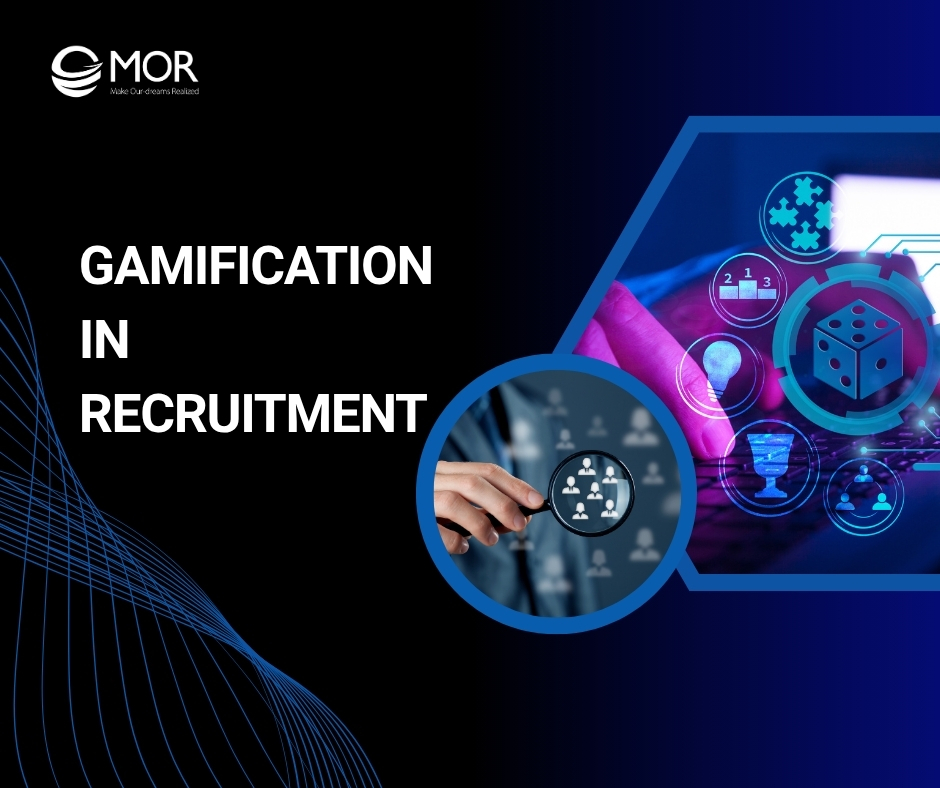
Finding the right talent is harder than ever, and traditional hiring methods no longer cut it. Gamification in recruitment brings fun, focus, and fairness into hiring. In this guide, MOR Software breaks down how game-based hiring transforms candidate engagement and helps companies recruit smarter.
What Is Gamification In Recruitment?
Gamification in recruitment refers to the use of game mechanics like points, leaderboards, puzzles, and simulation challenges in different stages of hiring. It turns traditional steps such as job postings, screening, and onboarding into engaging, goal-driven experiences that motivate candidates to perform at their best. What is gamification in recruitment really about? It’s about replacing dull application forms with interactive activities that reveal real skills and personality fit.
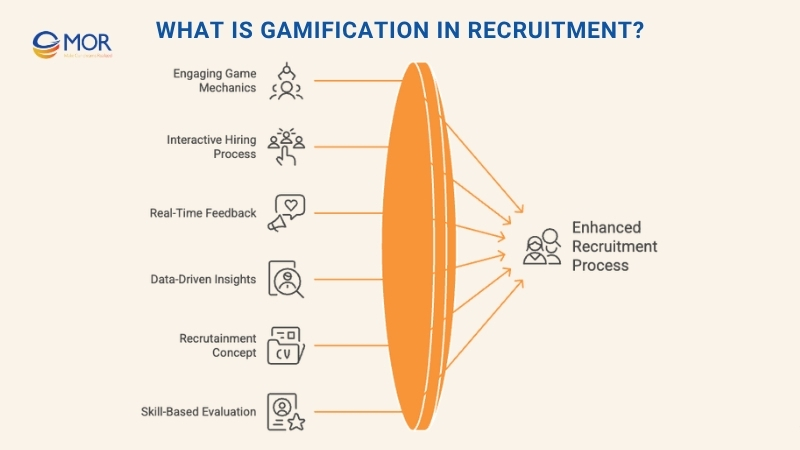
Instead of relying only on interviews or written assessments, companies now use machine learning and gamification in recruiting to make the process more dynamic and data-driven. Candidates earn rewards, unlock levels, and receive instant feedback, creating a sense of progress similar to playing a game. This approach not only keeps applicants more engaged but also helps recruiters gather better insights into performance and problem-solving ability.
The concept, often called 'recrutainment', works in both online and offline settings. Some companies design gamification in recruitment examples like virtual simulations, mini-games, or group role-play sessions that test how candidates handle pressure, collaborate, or think creatively. In short, gamification transforms hiring into an experience that’s both fun and informative for everyone involved.
Why Companies Are Turning To Gamification In Recruitment
The competition for skilled candidates keeps growing, and standard hiring methods, CV reviews, structured interviews, and written tests, often fall short in revealing a person’s true potential. That’s why many organizations are shifting toward gamification in recruitment, a modern hiring strategy that transforms the process into something interactive, measurable, and far more engaging.
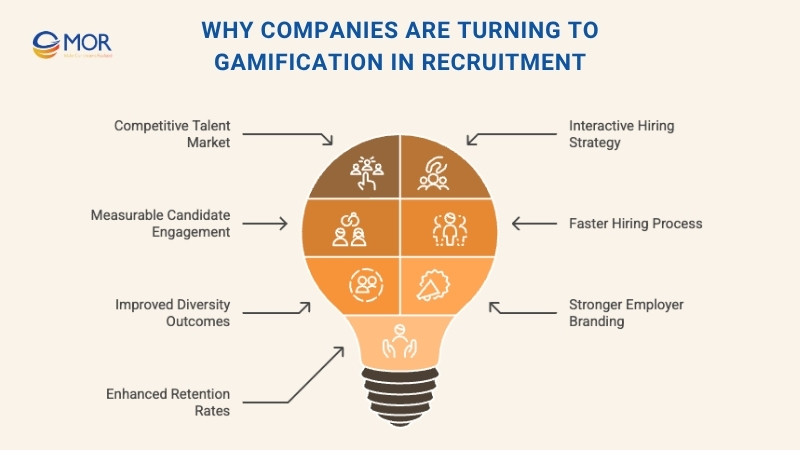
Through this approach, companies use challenges, leaderboards, and simulations to evaluate real-world abilities instead of relying on surface-level data. This not only helps identify stronger talent but also creates a hiring experience that feels enjoyable for applicants. According to recent studies, employers using gamification in recruitment report remarkable results: engagement levels rise by about 60%, the average hiring time drops by roughly 40%, and diversity hiring improves by more than a quarter. The most impressive part is retention, turnover rates have fallen from around 25% to just 8%.
These numbers make it clear why use gamification in recruitment has become a priority. It builds stronger connections with candidates, strengthens employer branding, and provides human resource development teams with richer insights than any traditional assessment ever could.
Benefits Of Gamification In Recruitment For Candidates
Gamified hiring is changing how people experience job applications. Instead of lengthy forms and tense interviews, gamification in recruitment gives candidates a chance to engage, play, and prove their strengths in a creative way. Below are some of the most meaningful advantages this approach brings.
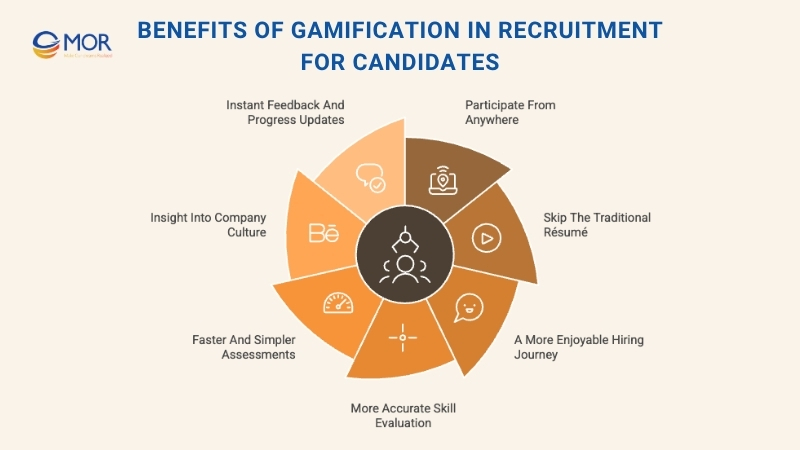
1. Participate From Anywhere
One of the biggest perks of gamification in graduate recruitment is flexibility. Candidates can complete assessments or challenges remotely, whether from home or while traveling. This not only saves time but also reduces the anxiety of formal interviews, helping applicants perform more naturally and show their real problem-solving skills in a comfortable setting.
2. Skip The Traditional Résumé
With gamified hiring, there’s no need to rely solely on a résumé. Instead of listing skills on paper, candidates get to show what they can actually do through tasks and game-based simulations. Recruiters gain deeper insights from these interactions, making it easier to identify talent that fits the role and company culture.
3. A More Enjoyable Hiring Journey
When done right, gamification in recruitment examples create an engaging and memorable experience. Interactive games, challenges, and feedback loops keep candidates interested throughout the process. A positive candidate experience matters, a recent study found that nearly 60% of job seekers turn down offers after a poor experience. Gamified assessments leave a better impression, making applicants more likely to accept and advocate for the brand.
4. More Accurate Skill Evaluation
Traditional hiring often depends on interviews and written tests, which may not fully reveal a person’s real abilities. With gamification in recruitment, candidates face challenges and simulations built around job-related skills. This method captures how they think, react, and solve problems in real time. The outcome is a data-driven evaluation that helps recruiters identify talent with the right mix of expertise and mindset.
5. Faster And Simpler Assessments
One major strength of gamification in HR is efficiency. Instead of lengthy assessments, gamified hiring offers short, focused challenges that test specific abilities. Candidates complete these tasks faster, recruiters get results sooner, and the entire process feels smoother for both sides. The time saved reduces dropouts and keeps applicants motivated throughout the journey.
6. Insight Into Company Culture
Many gamification examples in recruitment include scenarios or virtual missions inspired by real workplace situations. Through these activities, applicants experience the company’s tone, teamwork style, and values. This helps candidates decide if they align with the organization’s culture, improving long-term satisfaction and retention once they join.
7. Instant Feedback And Progress Updates
In traditional hiring, candidates often wait weeks for feedback. Gamified systems change that. Participants receive real-time scores, badges, or progress reports immediately after each stage. This quick response builds transparency, keeps candidates engaged, and gives them a sense of growth, strengthening their trust in the company from the very start.
>>> Let's implement AI in recruiting automation can transform the entire recruitment workflow with MOR Software and enhance hiring efficiency and strength
Top 5 Practical Ways To Apply Gamification In Recruitment
Now that you understand the concept, let’s see how gamification in recruitment works in real scenarios. The goal is to make hiring both smarter and more enjoyable. Below are five proven ways companies are using this method to attract and assess talent effectively. Remember, every organization is different, adjusting these ideas to fit your process will make all the difference.
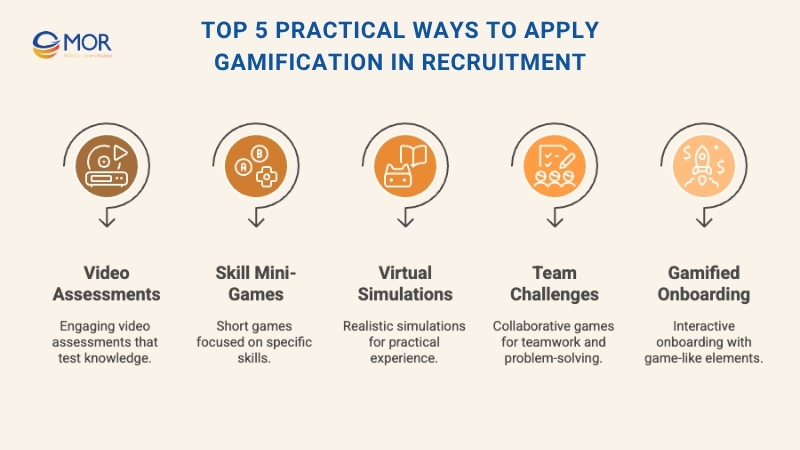
1. Interactive Video Assessments
Video interviews are standard today, but they don’t have to feel mechanical. By introducing game-style elements like timed responses, live challenges, or decision-based scenarios, you can turn interviews into interactive assessments that reveal more than scripted answers ever could. These activities test how candidates think under pressure and respond to real-world problems, skills that matter far more than rehearsed replies.
This approach works especially well for roles that demand analytical or technical expertise. Candidates might solve coding puzzles, complete logic tasks, or make quick decisions on simulated business cases. The best gamification in recruitment examples combine smart tools, smooth user experience, and strong evaluation criteria. Before launching, test the HRM models thoroughly to ensure performance and fairness for every participant.
2. Skill-Based Mini-Games
Hiring someone with the right technical skills but lacking teamwork or communication abilities is a common challenge. That’s where gamification in recruiting changes the game. By adding interactive, skill-based challenges early in the process, companies can evaluate both hard and soft skills in a more practical way.
These assessments can take the form of short mini-games or simulations that test real competencies. For instance, a literacy or problem-solving quiz can help evaluate attention to detail, while a timed coding challenge reveals how a developer handles pressure. When gamification in recruitment examples include leaderboards or point systems, candidates feel motivated to perform their best.
This competitive yet enjoyable setup not only keeps applicants engaged but also provides recruiters with measurable data. Scores and progress metrics make it easier to identify top performers quickly, helping hiring teams make more confident, evidence-based decisions.
3. Immersive Virtual Simulations
Virtual simulations are one of the most effective ways to bring gamification in recruitment to life. They recreate real workplace environments and challenges, allowing recruiters to see how applicants think, act, and solve problems under realistic conditions.
Through gamification in recruitment examples like simulated customer interactions, project management scenarios, or problem-solving missions, companies gain deeper insight into behavioral traits such as communication, adaptability, and decision-making. These qualities are often hard to measure in traditional interviews.
For instance, a company hiring for a customer support position might use a virtual scenario where candidates must manage incoming requests, prioritize issues, and respond to customer messages. Watching how they handle time pressure and empathy reveals more about job readiness than a standard Q&A session ever could.
As a result, virtual simulations turn screening into a practical test of skill rather than theory, helping recruiters identify genuine talent faster and with greater confidence. This approach demonstrates the real benefits of gamification in recruitment, making it a valuable analytics tool for modern hiring teams.
4. Team Challenges And Group Games
For positions where teamwork defines success, gamification in recruitment through collaborative challenges is a powerful approach. Candidates can join virtual or in-person group tasks designed to solve a shared problem or achieve a collective goal.
These gamification in recruitment examples reveal much more than a résumé ever could. As participants brainstorm, negotiate, and adapt, recruiters can easily spot natural leaders, strong communicators, and dependable team players.
This interactive format also highlights how each individual fits into a team dynamic, who steps up under pressure, who listens well, and who brings balance to the group. It’s a practical, engaging way to evaluate collaboration skills before hiring even begins.
5. Gamified Onboarding Experiences
The power of gamification in recruitment doesn’t stop once the offer is accepted. It can continue through onboarding, helping new hires feel more connected and confident from day one. Interactive games, scenario-based learning, and virtual missions make training more engaging while reinforcing company values and expectations.
Organizations can use leaderboards, progress bars, or digital badges to spark friendly competition among new employees. As recruits complete modules, hit milestones, or demonstrate key behaviors, they earn points and rewards that make the process motivating and memorable.
This method not only helps people learn faster but also strengthens team spirit. Many companies that use gamification report higher engagement and faster adaptation among new hires. To make it work, design your onboarding games around actual job tasks, keep them mobile-friendly, and collect feedback to improve each round. The result is a more energized, well-prepared workforce ready to contribute from the start.
How To Successfully Implement Gamification In Recruitment
Implementing gamification in recruitment takes more than just adding games to your hiring process. It requires clear strategic HRM plan, the right tools, and a well-structured plan to ensure every challenge leads to meaningful insights about your candidates.
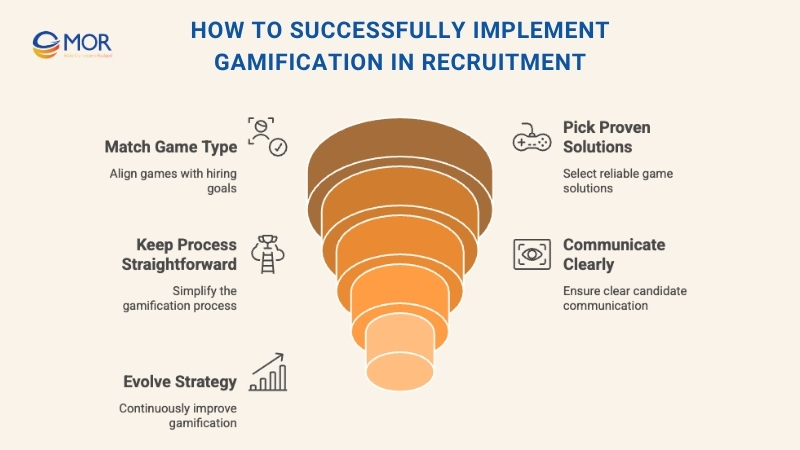
1. Match Game Type With Hiring Goals
Every role calls for a different kind of challenge, and the same logic applies when designing gamification in recruitment. The type of game you select should match what you’re trying to evaluate. For example:
- Quizzes are great for testing subject knowledge or basic industry understanding.
- Challenges work well for assessing creativity or technical ability.
- Puzzles measure analytical and problem-solving skills.
- Races help evaluate speed, focus, and task efficiency.
- Mazes test logical thinking and adaptability.
- Avatar-based games reveal how candidates handle real-world behavior, like resolving customer issues.
- Team-based tasks highlight collaboration, communication, and leadership qualities.
Through aligning the activity with your objective, you make sure the assessment feels relevant, fair, and meaningful. This approach keeps candidates motivated while giving recruiters accurate insights into who’s the right fit.
2. Pick Reliable, Proven Game Solutions
The effectiveness of gamification in recruitment depends heavily on the quality of the games you use. A well-chosen platform can reveal valuable insights into candidate performance and behavior, while a poor one risks skewed results or disengagement. Keep these points in mind when selecting the right HRMS software solutions:
- Research-Based Design: Choose tools grounded in behavioral science or validated research to guarantee credible and accurate evaluations.
- Trusted Providers: Work with vendors who have a proven track record. Look for those who can share case studies, client testimonials, or measurable success stories.
- Role Relevance: Each game should connect directly to the skills needed for the job. For example, a problem-solving challenge fits an analyst better than a creative designer.
- Engagement Value: The experience should be interactive, visually appealing, and enjoyable so candidates stay invested from start to finish.
- Smart Investment: The solution must be cost-effective. Weigh the price against benefits such as better hiring accuracy, faster time-to-hire, and stronger candidate engagement.
Reliable gamification in recruitment examples often combine science-backed assessments with seamless user experience, ensuring fair evaluation and lasting employer credibility.
3. Keep The Process Straightforward
The purpose of gamification in recruitment is to make hiring more engaging, not confusing. Games should be simple enough that candidates understand what to do without extra guidance. If the objective or rules feel unclear, people may lose interest, or worse, form a negative impression of your company.
Keep every challenge focused on measuring core skills that actually matter for the job. Avoid adding flashy but irrelevant elements that distract from assessment accuracy. A clean, well-structured game also reduces the risk of technical glitches and ensures a smoother experience for everyone involved.
Simplicity doesn’t mean dull, it means intuitive. When gamification in HR feels effortless to play and purposeful in design, candidates enjoy the process while recruiters collect more reliable, comparable data.
4. Communicate Clearly With Candidates
While gamification in recruitment adds fun and innovation to hiring, it should never feel like a gimmick. Candidates deserve to know why they’re playing and what the results mean. Being open about the goals and evaluation criteria helps them take the process seriously and see it as a fair opportunity to showcase their strengths.
Explain what the game measures, whether it’s teamwork, logic, or creativity, and how the results contribute to the final decision. This level of transparency shows respect for their time and effort, fostering trust from the very start.
Clear communication also strengthens your employer brand. When applicants understand the purpose behind gamification in recruitment examples, they’re more likely to view your company as credible, modern, and people-focused rather than experimental or impersonal.
5. Keep Evolving Your Gamified Strategy
Like any modern HR risk management tool, gamification in recruitment works best when it keeps growing. The hiring landscape changes quickly, and what feels exciting today may seem outdated next year. To stay effective, your gamified process should evolve through regular testing, updates, and feedback analysis.
Track not just who you hire but how candidates engage with each game. Look for signs of frustration, confusion, or drop-offs. Gathering feedback from both successful and unsuccessful applicants helps pinpoint what needs refining, maybe a task feels too long, or an assessment no longer matches the role.
As new technologies and gameplay mechanics emerge, update your system to stay fresh and relevant. Whether it’s integrating AI-driven scoring or adding mobile-friendly features, each improvement enhances the candidate experience. This commitment to progress keeps your gamification in recruitment approach meaningful, fair, and aligned with how top talent expects to engage with forward-thinking employers.
Leading Companies Using Gamification In Recruitment
Many global organizations are embracing gamification in recruitment to make hiring more engaging, fair, and insightful. These forward-thinking brands use game-based assessments to attract top candidates, evaluate real skills, and build stronger connections with future employees.
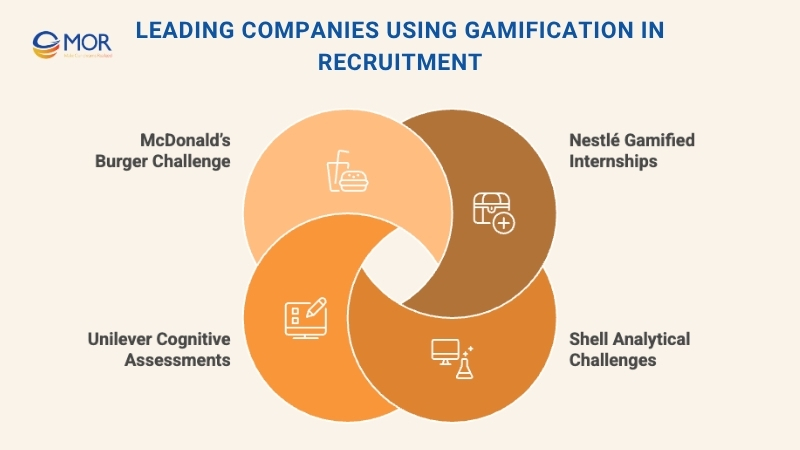
Nestlé
As one of the world’s largest food and beverage corporations, Nestlé runs its Nestership internship program using gamified assessments. The goal is to identify young, high-potential talent while making the recruitment experience more interactive and appealing. This move has strengthened Nestlé’s reputation as an innovative and people-focused employer.
Shell
Shell, the Dutch-British energy giant, partnered with The Talent Games to apply gamification in recruiting for its internship programs. Candidates complete engaging online challenges that measure analytical thinking, decision-making, and teamwork, helping Shell pinpoint the best-fit applicants quickly and efficiently.
Unilever
Unilever has been using gamification in recruitment since 2016 to connect with digitally savvy graduates. Through short, game-based assessments, the company evaluates cognitive ability and problem-solving in real time, followed by video interviews. This modern approach has streamlined Unilever’s hiring pipeline and improved diversity outcomes.
McDonald’s
McDonald’s Australia famously introduced the Macca’s Burger Challenge, a playful online game designed to recruit thousands of team members nationwide. The challenge lets candidates experience real job scenarios while showing their multitasking and customer service skills in action.
These companies that use gamification prove that when hiring feels like a game, both candidates and employers win, creating a more engaging, transparent, and effective recruitment process.
Partnering With MOR Software For Gamification In Recruitment
At MOR Software, we help companies bring gamification in recruitment to life through tailored software solutions and smart integrations.
Our teams design interactive platforms, assessment systems, and analytics dashboards that make hiring more engaging and data-driven.
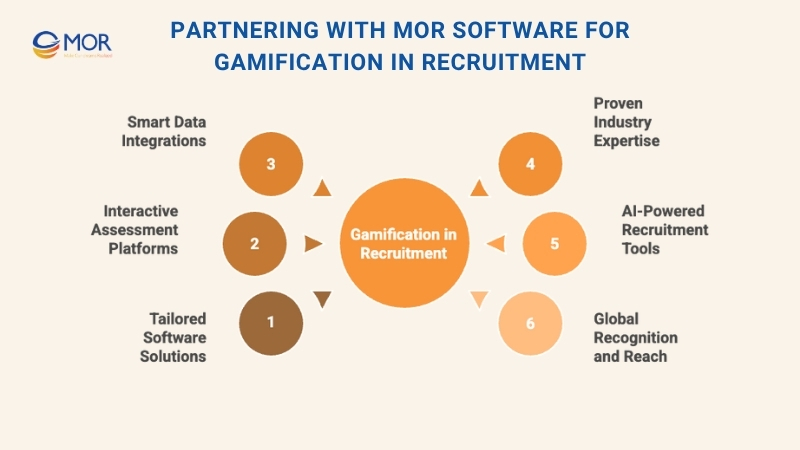
With over 850 projects across 10+ countries and recognition as one of Top 10 Vietnam software outsourcing company, we combine creativity, psychology, and technology to build systems that attract and evaluate talent more effectively.
From AI-powered game assessment tools to mobile-friendly recruitment apps, our expertise ensures that gamified hiring delivers real results, stronger engagement, faster decisions, and better hires.
Contact us to explore how we can help transform your recruitment strategy through gamification.
Possible Drawbacks Of Gamification In Recruitment
While gamification in recruitment brings creativity and engagement to hiring, it’s not without challenges. Understanding its limitations helps companies apply it more responsibly and effectively.
- Limited Skill Coverage: Not every game captures all the qualities needed for a role. While it can measure logic or problem-solving, it may miss deeper traits like empathy, leadership, or communication.
- Accessibility Concerns: Some candidates may not enjoy or feel comfortable with game-based assessments. This can unintentionally exclude talented individuals who prefer traditional evaluations.
- Technical Complexity: Building and managing gamified systems requires time, money, and technical skill. A poor or buggy experience can harm your brand image and frustrate participants.
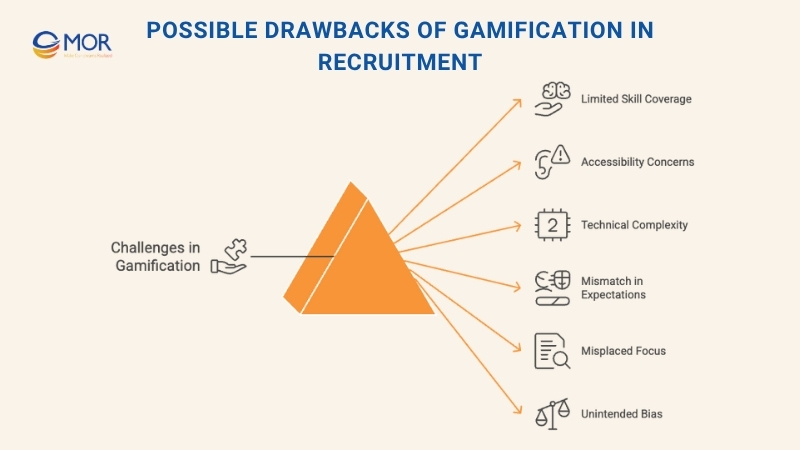
- Mismatch In Expectations: A playful hiring process might not resonate with every applicant, especially for senior or highly technical roles where professionalism is key.
- Misplaced Focus: If recruiters rely too heavily on game scores, they risk overlooking essential qualities that matter more to real job performance.
- Unintended Bias: Without careful design, some games can favor specific thinking or reaction styles, introducing bias instead of removing it.
Considering the pros and cons of gamification ensures that innovation strengthens, not complicates, your recruitment strategy.
The Future Of Gamification In Recruitment
The next phase of gamification in recruitment will be driven by smarter technology and deeper personalization. With AI automation, data analytics, and virtual reality now shaping how companies connect with talent, game-based hiring is set to become even more immersive and predictive. Early studies show that gamified recruitment can improve candidate engagement by up to 150% compared with traditional assessments, a clear signal that interactive hiring is here to stay.
AI automation tools already help recruiters match skills to job requirements more accurately, while VR allows candidates to experience realistic job simulations before joining. This blend of automation and immersion creates a more human experience, where applicants feel both challenged and understood.
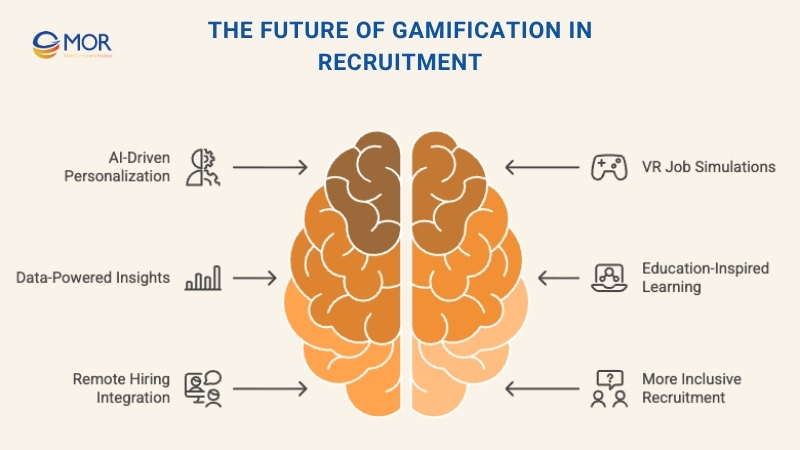
We’re also seeing lessons borrowed from education and gaming industries. Schools using game-based learning report motivation rates exceeding 65%, showing how interactivity drives stronger outcomes. The same principle applies to gamification in recruitment, where engaging environments help identify creativity, resilience, and emotional intelligence, traits that standard interviews often miss.
As remote and hybrid work continue to grow, these digital assessments will become essential for keeping virtual hiring interactive and fair. Companies that adapt early will attract tech-savvy candidates who expect more than a résumé submission, they expect an experience.
Looking ahead, the evolution of gamification in recruitment promises not just better engagement, but smarter, faster, and more inclusive hiring for the future workforce.
Conclusion
Gamification in recruitment is redefining how companies attract and assess talent, making hiring more engaging, fair, and insightful. By turning evaluations into interactive experiences, businesses gain deeper insights while candidates stay motivated throughout the process. With MOR Software’s proven expertise in building smart, scalable recruitment systems, your company can move beyond traditional hiring and create an experience that truly stands out. Contact us to start building your gamified hiring solution today.
MOR SOFTWARE
Frequently Asked Questions (FAQs)
What does gamification in recruitment mean?
Gamification in recruitment means applying game mechanics like points, levels, and leaderboards to hiring processes. It turns job applications, assessments, or onboarding into interactive experiences that reveal how candidates think and perform.
How does gamification improve the hiring process?
It creates a more engaging experience for candidates while giving recruiters measurable data. Gamified tasks show real-world behavior, problem-solving ability, and teamwork, helping companies identify top talent faster and more accurately.
What is AI and gamification in hiring?
AI and gamification in hiring combine technology and psychology to improve recruitment. Artificial intelligence analyzes game performance data to evaluate cognitive skills, problem-solving patterns, and personality traits, matching candidates to roles more effectively.
Do Gen Z candidates like gamification?
Yes. Gen Z prefers interactive and immersive experiences over traditional tests or forms. Gamified hiring lets them actively participate in challenges and simulations, making recruitment feel more like an experience than an evaluation.
What are some examples of gamification in recruitment?
Examples include online coding challenges, virtual reality job simulations, problem-solving games, timed quizzes, and role-based scenarios where candidates earn points or badges for completing tasks.
Which companies use gamification in recruitment?
Leading global companies like Unilever, Shell, Nestlé, and McDonald’s have used gamified recruitment campaigns to attract young talent, evaluate skills, and increase diversity in their hiring pipelines.
What are the main benefits of gamification in recruitment?
It improves engagement, reduces bias, saves time, and helps recruiters assess both hard and soft skills. Candidates gain a better understanding of company culture and enjoy a smoother, more enjoyable process.
Are there any drawbacks to gamified hiring?
Yes. Gamification requires careful design and testing. If games are too complex or not accessible, they can discourage candidates. There’s also a risk of focusing too much on scores instead of deeper evaluation.
How can small businesses start using gamification in recruitment?
Start with simple tools like online quizzes or micro-challenges that assess job-relevant skills. Use free or low-cost gamified platforms, or integrate game-like progress tracking into onboarding and employee training.
What’s the future of gamification in recruitment?
The future will blend AI, VR, and analytics to make hiring more personalized and predictive. As remote work grows, gamified platforms will help recruiters engage candidates globally through immersive, skill-based experiences.
Rate this article
0
over 5.0 based on 0 reviews
Your rating on this news:
Name
*Email
*Write your comment
*Send your comment
1